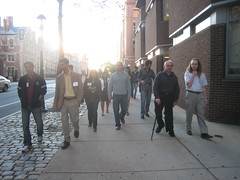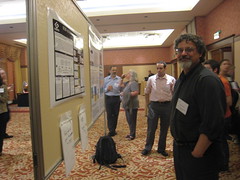
Imagine a conference where the sole purpose is to build virtual humans. In order to do so, everyone needs to understand what it is to be human. This creates a quite special kind of crowd. This crowd just had a 3 day conference in Pennsylvania, showing and discussing their latest IVAs, that is, Intelligent Virtual Agents. In almost all conversations at this conference there is a meta-activity going on. For example, yesterday when we walked to the place where the conference dinner was going to be, I asked the woman next to me what she was working on. She says:
"Nodding behaviours."
"Oh", I said, nodding, "Interesting."
"Yeah" (nods), "but not in the listening behaviour, but in the one speaking"
We talked back and forth about nodding, we had both spent time in Tokyo doing research, and I associated to the presentation I saw at ACE2008 where life size nodding robots where placed in lecture halls, something that both made the lecturer more confident, both because of seeing the nodding dolls in the back, and because the behaviour propagated in the room, resulting in that lectures where nodding robots had been present increased the perceived persuasiveness of the lecturer. Noddingly we agreed that it would be great in Japan, but strange in Sweden or in the United States. I for one, started to count our nods during the conversation.
A similar thing happened the evening before, when I presented my poster about semi-autonomous avatars. We were three persons talking, and we kept monitoring the circle our feet created, as well as how our upper bodies where leaning. The circle grew, and we kept observing, in parallel with the conversation that flowed from topic to topic, how our circle acted as it grew to perhaps six or seven people. We also made note of how the turn-taking happened as we were speaking and allowing each other a quite good balance in the conversational space. (when the 8th came we couldn't sustain it and the group naturally became three new little circles) So I wasn't surprised the day after (but delighted) when it turned out that Hrafn, Claudio, and Hannes, who were part of the poster-circle, had built an application that simulated these behaviours .
Stacy Marcella visited my poster on semi-autonomous avatars, then he fetched Hannes Vilhjalmsson and some other people, and we formed a circle similar to this:
A screenshot from Hrafn Thórisson's presentation on their 'Multiparty Multimodal Dialogue Architecture with
Realtime Turntaking' A title that I kept giving the melody of itsy bitsy teen....
When I decided to go to IVA'10 I had a few reasons for it:
1. Michael Mateas, Marliyn Walker and Jenny Brusk said (in separate conversations) that it is a great conference and that I would find it both interesting and useful, and that I would probably meet lots of people with whom I would enjoy talking.
2. I was curios about the tools session: Would I find tools that would be useful in research to me and others at the department, and perhaps useful for our students?
3. Last month I had long conversations with a friend at Blizzard who is an AI/Game-play programmer about the scope of game AI - how it is seen as a set of tools, but different tools depending on whether you are in the industry or in the academia, and even then, different subsets of tools depending on the subject area you happen to work in. In games it is hard to separate between what is 'AI' and what is game-play mechanics, but something which we are both clear about is that we need to talk more about smart systems, where the blocks/modules are tightly connected to the world architectures. This is where the IVAs come in. My question to the conference when coming was: Is it more than talking heads?
I got feed for thought regarding all the three points above, and I will expand on them later. Now I have a plane to catch to Stockholm.

